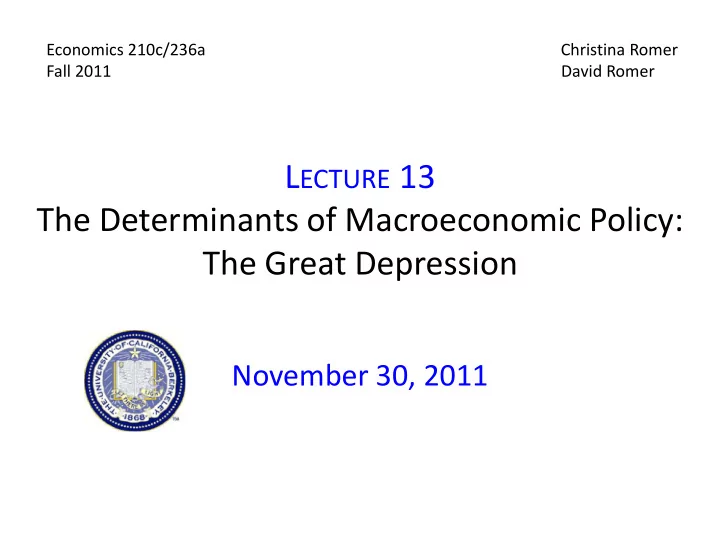

Economics 210c/236a Christina Romer Fall 2011 David Romer L ECTURE 13 The Determinants of Macroeconomic Policy: The Great Depression November 30, 2011
I. R EVIEW OF G REAT D EPRESSION F ACTS AND E XPLANATIONS
Industrial Production (Logarithms) 1.2 1.4 1.6 1.8 2.2 2.4 1 2 1929-01 Industrial Production, 1929 to 1941 1929-07 August 1929 1930-01 1930-07 1931-01 1931-07 1932-01 1932-07 March 1933 1933-01 1933-07 1934-01 1934-07 1935-01 1935-07 1936-01 1936-07 May 1937 1937-01 1937-07 June 1938 1938-01 1938-07 1939-01 1939-07 1940-01 1940-07 1941-01 1941-07
Explanations • Aggregate demand contraction • Stock market crash • Money supply contraction • Credit contraction • Increased nominal rigidity • Supply-side stories
II. J ONATHAN R OSE , “H OOVER ’ S T RUCE : W AGE R IGIDITY IN THE O NSET OF THE G REAT D EPRESSION ”
Commercial Paper Rate (Percent) 0 1 2 3 4 5 6 7 8 9 01/03/1920 10/09/1920 07/16/1921 04/22/1922 01/27/1923 Commercial Paper Rate 11/03/1923 08/09/1924 05/16/1925 02/20/1926 11/27/1926 1920-1941 09/03/1927 06/09/1928 03/16/1929 12/21/1929 09/27/1930 07/03/1931 04/09/1932 01/14/1933 10/28/1933 08/04/1934 05/11/1935 02/15/1936 11/21/1936 08/28/1937 06/04/1938 03/11/1939 12/16/1939 09/21/1940 06/27/1941
White House Press Statement Following the November 21, 1929 Conference
Source: Rose, 2010.
Decline in Industrial Production in 1920 and 1929 9 8 7 6 1929 5 1920 4 3 1 2 3 4 5 6 7 8 9 10 11 12 13 14 15 16 17 18 19 20 21 22 23 24 Months following Peak
Source: Rose, 2010.
Source: Rose, 2010.
III. H SIEH AND R OMER , “W AS THE F EDERAL R ESERVE C ONSTRAINED BY THE G OLD S TANDARD D URING THE G REAT D EPRESSION ? E VIDENCE FROM THE 1932 O PEN M ARKET P URCHASE P ROGRAM ”
Source: Hsieh and Romer, 2006.
Indicators of Devaluation Expectations • Forward exchange rate premium • Did forward rates rise relative to spot rates? • Interest rate differential • Did U.S. interest rates rise relative to foreign?
Source: Hsieh and Romer, 2006.
Was the Fed worried about gold flows? Source: Hsieh and Romer, 2006.
Source: Hsieh and Romer, 2006.
Role of Conflict Between Federal Reserve Banks Source: Hsieh and Romer, 2006.
Role of Ideas Source: Hsieh and Romer, 2006.
Source: Hsieh and Romer, 2006.
IV. H AROLD C OLE AND L EE O HANIAN , “N EW D EAL P OLICIES AND THE P ERSISTENCE OF THE G REAT D EPRESSION ”
Model NRA Code Source: Chandler (1970)
Source: Cole and Ohanian
Source: Cole and Ohanian
Source: Romer (1999)
Source: Temin and Wigmore (1990)
Source: Cole and Ohanian
Does It Matter that Cole and Ohanian Don’t Explain Why Output Was So Low before the NRA? • What does their analysis imply output growth would have been in 1934 in the absence of the NRA? • With nominal rigidity and i = 0, what are the effects of a fall in potential output?
Source: Eggertsson (2008)
Source: Temin and Wigmore (1990)
V. G AUTI E GGERTSSON AND B ENJAMIN P UGSLEY , “T HE M ISTAKE OF 1937”
Source: Friedman and Schwartz (1963)
Source: Chandler (1970)
The Key Elements of Eggertsson’s and Pugsley’s Proposed Explanation • A change in expectations of future policy. • The economy is incredibly sensitive to those expectations: A change from a situation where “the public fully believes that the government is committed to targeting 4 percent inflation” to one where “the public thinks there is a 5 percent chance that the government will [adopt] a zero inflation goal within the next two years … results in a double-digit output collapse and deflation” (Eggertsson-Pugsley, p. 3).
Other Theories of the Downturn • Friedman and Schwartz: A largely conventional monetary contraction caused by the increase in reserve requirements. • Telser and others: A fiscal contraction. • Cole and Ohanian and others: adverse supply shocks, especially from unionization.
Eggertsson and Pugsley’s Evidence • Narrative evidence from statements and actions. • Behavior of commodity prices. • Hamilton’s and Cecchetti’s estimates of expected inflation. • The behavior of the economy when statements and actions changed back.
Source: Eggertsson and Pugsley
Source: Eggertsson and Pugsley
FDR as a Nominal GDP Targeter? Source: Eggertsson and Pugsley
Recommend
More recommend